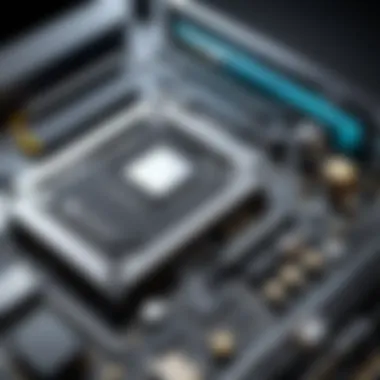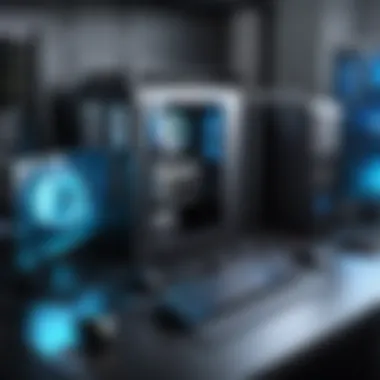Finding the Best Spot to Build Your Gaming PC


Intro
Selecting the best location for building your gaming PC is a crucial step that can greatly influence the outcome of your project. Different settings come with their own sets of challenges and advantages. Novice builders and experienced hobbyists alike must understand these factors to enhance their build experience. This article delves into the essential components to consider when choosing where to construct your gaming system.
Understanding your workspace is vital. An ideal environment not only speeds up the assembly process but also minimizes the likelihood of damaging sensitive components. By focusing on aspects such as space, tools, environmental conditions, and safety, you can set yourself up for a successful build. Let’s explore the key considerations.
Space Requirements
When selecting a location, the first thing to consider is the amount of space available. The work area should be spacious enough to accommodate tools, parts, and your PC case without causing obstruction. Cramped conditions can lead to mistakes and, ultimately, frustrations.
- A clean, flat surface is essential. This could be a dedicated desk or table.
- Make sure to eliminate clutter from your workspace to prevent accidents.
- Ensure that your chosen area has good lighting. Poor visibility can lead to missing important details during the build.
Tools and Components
Different tools play a significant role in how effectively you can build your PC. To ensure an efficient assembly process, gather essential items ahead of time.
- Screwdrivers (both Phillips and flathead)
- Anti-static wrist strap to protect components from static electricity
- Tweezers for small connections
- Cable ties for organization
Additionally, ensure you have all the components ready, such as the motherboard, CPU, GPU, RAM, and power supply.
Environmental Conditions
The environment can significantly impact the building process. Factors such as temperature, humidity, and air quality must be considered.
- Temperature: It is best to work in a cool, dry environment. Excess heat can affect the components and your concentration.
- Humidity: High humidity levels can cause condensation, which is harmful to electronic parts.
- Air quality: Ensure adequate ventilation in your workspace to prevent dust accumulation, which can damage sensitive parts.
Safety Precautions
Lastly, safety cannot be overlooked. A safe workspace is an efficient workspace. Here are some points to keep in mind:
- Always wear gloves while handling components to avoid oils from your fingers damaging the hardware.
- Keep a fire extinguisher nearby, just in case.
- Be mindful of cable management to prevent tripping hazards in your workspace.
A well-thought-out workspace can save you time, frustration, and potential damage to costly parts.
Preface
Choosing the right location for building a gaming PC is not a trivial task. It requires careful consideration of various factors that can impact both the building process and the eventual performance of the system. The environment in which one builds can dictate the ease of assembly, the organization of components, and even the long-term reliability of the setup. This article aims to provide insights and guidance to both novice and experienced builders, focusing on critical elements to create an efficient and effective building experience.
Importance of Choosing the Right Location
Selecting an appropriate location is crucial for a successful assembly of a gaming PC. A well-chosen site not only facilitates a smooth building process but also reduces the risk of errors and accidents. The right environment allows for better organization of tools and components, minimizing frustration. Furthermore, an ideal workspace promotes clear focus, lessening distractions that could compromise the quality of the build. In short, the location sets the stage for an engaging and more enjoyable experience.
Overview of Gaming PC Components
Understanding the various components of a gaming PC is essential to identify how the space will be utilized effectively. Key components include the CPU, GPU, RAM, and storage drives, all of which come in different shapes and sizes. Having knowledge of these parts helps in planning the arrangement and ensuring proper airflow.
Components can be broken down into several categories:
- Central Processing Unit (CPU): Often referred to as the brain of the computer, handling instructions and tasks.
- Graphics Processing Unit (GPU): Responsible for rendering images and video, crucial for gaming performance.
- Memory (RAM): Used for temporary data storage, impacting system speed.
- Storage: This includes hard drives and solid-state drives, where data and applications are stored.
- Motherboard: The main circuit board that connects all components.
When building a gaming PC, a clear understanding of these parts ensures they are handled with care and properly configured in your workspace.
Initial Considerations for Location Selection
Selecting the right location to build your gaming PC is a crucial step that can significantly influence both your building experience and the longevity of your components. It revolves around a few specific aspects that harmonize together: space requirements, tools and equipment, and how these elements interact with each other. Each factor contributes to an efficient workspace while minimizing potential setbacks. A well-thought-out selection can save time, reduce frustration, and enhance the overall building process, making it smoother for both beginners and seasoned builders alike.
Space Requirements
Available Surface Area
The available surface area is fundamental when selecting a location. A clear, spacious workstation allows for the organized well-being of components, preventing overlap or accidents. A large surface helps in maintaining order and offers room to expand if necessary. In this context, a table or desk with sufficient area will support the motherboard, graphics card, and other components without feeling cramped. A spacious setup is beneficial for the overall workflow. However, choosing a smaller area may limit movement, leading to potential mishaps.
Accessibility


Accessibility pertains to how easy it is to reach tools and components during the building process. Selecting a location that provides convenient access to everything is essential. An ideal space ensures you can quickly grab tools without unnecessary movement. This can speed up the assembly process and help maintain focus. For instance, having tools within arm's reach might lead to faster decision-making, while a cluttered or far-off area might require added steps that can interrupt the workflow.
Organization of Components
Organization of components refers to how you arrange your tools and parts at the workspace. A well-structured area allows for easy identification and retrieval of items as needed. Keeping components organized can reduce the risk of losing items or mixing parts that may not belong together. Using bins or trays for various screws, cables, and parts ensures they remain separated and can expedite the workflow when building. Poor organization may lead to frustration and potentially damaging mistakes.
Tools and Equipment
Essential Tools
Essential tools are the backbone of any successful PC build. A basic toolkit should include a screwdriver set, anti-static wrist strap, and zip ties for cable management. Having quality tools simplifies the assembly process and can prevent damage to components. The right tools minimize the risk of stripping screws or damaging delicate parts, making them crucial to the overall goal of a successful build. Without proper tools, even simple tasks can become challenging and could lead to serious errors.
Storage for Tools
Storage for tools is important to prevent chaos at your workstation. A designated storage area keeps essential tools organized and accessible during the build process. This might include a tool bag or box where tools are kept in an orderly fashion. Having a clear storage solution helps streamline the building process and eliminates the need to search for tools or parts when they are needed. It prevents the distractions that can arise from a disorganized workspace.
Power Sources
Power sources refer to how you plan to provide electricity to your components and tools. An ideal building location should have easy access to outlets and power strips with surge protectors. Power management is essential for keeping devices safe from electrical surges. Ensuring that the workstation is equipped with enough power sources prevents interruptions during assembly and ensures that tools can operate smoothly when needed. A shortage of power sources, conversely, can risk damaging sensitive components and prolong assembly time.
Environmental Conditions
Understanding environmental conditions is essential when constructing your gaming PC. The right surroundings influence the performance and longevity of your components, and paying attention to factors such as temperature, lighting, and dust management can lead to smoother assembly and better functionality.
Temperature Control
Cooling Solutions
Effective cooling solutions are vital to maintain an optimal temperature while building a gaming PC. Tools such as fans, liquid cooling systems, and heatsinks help transfer heat away from components. A key characteristic of good cooling solutions is their ability to efficiently manage heat, ensuring the system operates within safe parameters. Many builders prefer liquid cooling systems because they tend to be quieter and more effective in dissipating heat than traditional air coolers.
However, it's important to consider that liquid cooling adds complexity to the setup. If not installed correctly, it may lead to leaks, potentially damaging hardware. Therefore, understanding the unique features of your cooling solution can help you avoid pitfalls and improve performance.
Heat Generation from Components
Heat generation from components is another critical aspect. High-performance CPUs and GPUs produce significant heat, especially under load. This heat can impact stability and performance if not managed correctly. Focusing on heat generation can ensure you select components that are efficient, but also understand the implications for cooling systems and overall design.
Choosing components wisely can minimize heat output while still meeting performance needs. However, neglecting to consider heat generation can lead to overheating issues that result in throttling or crashes during gameplay or heavy tasks.
Lighting Conditions
Natural vs.
Artificial Light
Lighting conditions affect the building process and your comfortable working experience. Natural light provides an excellent source for visibility. It helps in spotting tiny components that need careful handling. On the other hand, artificial lighting is more controllable and can be adapted to suit different tasks. Builders often find that a mix of both works best.
Considering whether to use artificial light means evaluating the flexible options available. LED lights can illuminate workspaces well, yet excessive brightness can strain the eyes. Proper lighting choices can enhance focus and reduce errors during assembly.
Minimizing Eye Strain
Minimizing eye strain is another significant factor, especially during lengthy builds. Eyes can become tired if they are exposed to bright lights or small details for prolonged periods. Opting for adjustable lamps or indirect lighting can make a difference. A key characteristic of effective eye strain minimization is its relation to comfort and productivity.
Avoiding harsh glaring light helps maintain focus. Using blue light filters on screens and ensuring adequate breaks can prevent discomfort that might arise during long hours of work.
Dust and Debris Management
Cleaning Practices
Dust can be an enemy to your gaming PC. It accumulates and can block airflow, which affects cooling. Implementing regular cleaning practices before and after the build is essential. This includes cleaning the work area, ensuring no dust on components and tools, and using air duster products to clean inside cases both before and during assembly.
Cleaning methods establish a cleaner and more efficient workspace. However, builders should be cautious not to use too much liquid cleaners that can damage sensitive parts.
Protective Measures


Protective measures are another layer of defense against dust and debris. Using anti-static mats and covers can shield your components from dirt and electrostatic discharge. A key characteristic of protective measures is their ability to prolong the life of your investment. Proper coverings and mats can prevent unnecessary exposure to dust while handling parts, ensuring everything remains pristine.
However, it is vital to have these protective measures in place before you start assembling. Failing to do so can lead to significant issues during or after the construction process.
Key takeaway: Thoughtfully considering environmental conditions is critical for optimizing the building process. Temperature control, lighting choices, and dust management greatly affect your overall gaming PC construction experience.
Safety Considerations
Safety is a vital aspect when building your gaming PC. Addressing safety considerations can prevent damage to components and ensure the well-being of the builder. Many focus primarily on choosing the right components or the best tools without realizing that safety protocols are equally critical. Having safe practices in place protects not only the equipment but also the person assembling the rig. Smart safety strategies reduce accidents and build confidence during the build process.
Electrical Safety
Use of Surge Protectors
Surge protectors help prevent damage caused by electrical surges. These surges can occur during storms or fluctuations in power supply. Using surge protectors can save your high-value components from such unpredictable incidents. A key characteristic of surge protectors is their ability to absorb excess voltage. This feature makes them a popular choice among builders looking to safeguard their investments.
While surge protectors are quite effective, they do come with a disadvantage: if they are incorrectly rated or too old, they may fail to provide proper protection. Thus, ensuring that you select a quality surge protector suited for your needs is important.
Proper Grounding Techniques
Proper grounding techniques add another layer of safety when building a gaming PC. Grounding helps in eliminating possible static electricity that could damage sensitive components. An important aspect of this technique is ensuring that your workstation is grounded correctly. This practice is a beneficial choice for anyone assembling a system, as it reduces the risk of static discharge.
A unique feature of proper grounding is the use of anti-static wrist straps that wear around the arm. This method is often preferred by builders as it ensures constant grounding. However, it requires attention: failing to wear it properly might reduce its effectiveness, leading to potential hazards.
Ergonomics
Optimal Workstation Height
The optimal workstation height plays a significant role in ensuring comfort and efficiency during the assembling process. It should allow the builder to work without strain. A work surface that is too high or too low can cause discomfort, leading to distractions. Key characteristics include being at elbow height so that the arms can rest comfortably and supportively. This adjustment ensures builders do not tire quickly, thereby improving focus and productivity.
A downside to incorrect workstation height is that it can lead to fatigue or injury over time. Investing time in finding the right height can prevent these long-term issues.
Chair Comfort and Support
Chair comfort and support are equally crucial in setting up an ergonomic workspace. A quality chair should support your back during long assembly sessions. This can enhance concentration and reduce the need for frequent breaks. The key characteristic of a good chair is its adjustable features, which allow for individualized comfort settings. This makes it a beneficial choice for those who might spend extended periods assembling their gaming PCs.
However, not all chairs are designed equally. Some may lack sufficient support, leading to discomfort. Thus, testing different options before finalizing your choice saves you from making a regrettable purchase.
Remember, proper safety and ergonomic practices not only make your building process smoother but also secure your investment in technology.
Personal Preferences
Personal preferences play a significant role in determining an ideal spot for constructing your gaming PC. The environment where you build your system can greatly affect both your comfort level and the success of the assembly process. Choosing a space that aligns with your unique needs and desires will provide a more satisfying experience overall.
When planning the setup, consider factors such as noise levels and the presence of distractions. Both elements can influence your focus. Additionally, having a comfortable environment can enhance your productivity. Small changes in the atmosphere can lead to an effective building process, making it essential to assess your preferences.
Quiet vs.
Noisy Environments
Noise Control Solutions
Noise control solutions are vital for creating an optimal building environment. A quieter space helps to minimize distractions and allows you to concentrate better during the assembly process. Soundproofing materials, such as acoustic panels, can absorb unwanted noise, ensuring a calmer atmosphere.
The key characteristic of these solutions is their ability to mitigate external sounds without requiring significant changes to your existing setup. Many builders opt for simple installations like carpets or curtains, which can effectively reduce echoes and dampen sound.
However, it is important to recognize that these solutions might not eliminate all noise. This can be a disadvantage if you are in an area with persistent external sounds. Still, creating a quieter environment will undoubtedly enhance your focus on the task at hand.
Personal Comfort
Personal comfort is indispensable when selecting a building location. An ergonomic workspace ensures that you can work efficiently without straining your body. Components such as a supportive chair and appropriate desk height contribute to an environment where you feel relaxed.
The key aspect of personal comfort is how it directly influences your endurance during the assembly process. Happy builders are likely to be more focused and efficient. Selecting proper seating and ensuring adequate space for movement will help maintain an enjoyable experience.


However, it is essential to remember that personal comfort varies between individuals. What may feel comfortable for one person might not be the best for another. Therefore, it’s advisable to test different setups and find what works best for you.
Distractions and Focus
Minimizing Interruptions
Minimizing interruptions is crucial for maintaining focus while building your gaming PC. An environment free of distractions enables a smoother assembly process. This includes reducing conversations, notifications, or any other form of diversion.
The primary characteristic of this practice is the ability to create a designated space for building. Either a quiet room or a specific time dedicated to assembly can help sustain focus while preventing unexpected interruptions. Moreover, informing others about your project might help maintain a peaceful building process.
On the downside, strict boundaries may lead to feelings of isolation. Balancing social needs with the need for focus can be challenging but essential for ultimate success.
Setting Boundaries
Setting boundaries plays a significant role in minimizing distractions. This involves establishing clear rules about your workspace and informing others about your schedule. By doing so, you can particupate in your assembly project without unwarranted disturbances.
The key characteristic of establishing boundaries is the clear communication between you and those around you. It allows everyone to understand when you are unavailable and reduces unnecessary interruptions. In essence, this practice promotes a focused mindset.
Nevertheless, it can be difficult to maintain boundaries, especially in shared living spaces. Balancing personal projects and household dynamics requires an adaptable approach. But the effort spent in setting boundaries is often rewarded by a more productive and satisfying building experience.
Final Preparations Before Building
Before embarking on the assembly of your gaming PC, final preparations are crucial. It ensures a smooth process and helps avoid potential pitfalls. This stage allows you to streamline your efforts and gather all necessary elements and resources.
Checklists and Resources
Component Preparation
Component preparation is an essential step in getting ready for a build. It involves gathering all parts and ensuring each piece is in working order before starting the installation. Properly preparing components can significantly enhance the building experience.
The key characteristic of component preparation is thoroughness. Every part, including the motherboard, GPU, CPU, RAM, and storage drives, must be checked for damage or missing components. This careful assessment helps to avoid delays and complications later during assembly. A beneficial approach is to create a checklist that lists all components, allowing you to mark off items as you confirm their readiness.
The unique feature of component preparation is the opportunity it provides to familiarize yourself with each part. Knowing the specifications, connectors, and features of every component makes the build easier and more intuitive. However, neglecting this step can lead to confusion and errors during assembly, potentially complicating the process.
Assembly Instructions
Assembly instructions serve as critical guidance for your build process. They provide detailed steps on how to correctly install each component, ensuring both functionality and compatibility. Following assembly instructions can prevent mistakes, saving time and, sometimes, money.
The key characteristic of assembly instructions is their structure. They typically break down each phase of the build into understandable sections, guiding you through everything from motherboard installation to cable management. This structured approach is a popular choice for builders, as it minimizes the risk of making preventable errors.
A unique feature of detailed assembly instructions is the diagrams or images they often include. Visual aids help clarify complex steps, making them easier to follow. However, it is important to note that some instructions may not cover every possible scenario. Builders should be prepared to research any unfamiliar processes to fill in gaps.
Creating a Building Timeline
Creating a building timeline establishes a clear plan for your assembly process. This timeline helps allocate time for part preparation, assembly work, and testing phases. It is especially useful for first-time builders, ensuring each step is not rushed. A well-defined timeline allows builders to pace themselves and minimize stress.
Consider dividing your timeline into stages:
- Preparation Phase: Gather and test components.
- Assembly Phase: Follow instructions step-by-step.
- Testing Phase: Ensure all hardware works as intended, checking for any issues.
This organized approach can improve efficiency, leading to a more satisfying building experience.
Ending
Choosing the right location for building your gaming PC is a critical decision that can significantly impact the building process and your overall satisfaction with the finished product. Each element discussed in this article emphasizes various aspects that contribute to a successful assembly experience. From considering space and accessibility to ensuring proper environmental conditions and personal preferences, every detail matters.
Recap of Key Considerations
In recap, here are the key considerations when selecting the optimal location:
- Space Requirements: A clear and clutter-free surface is essential. Ensure you have enough room to lay out your components without feeling cramped. This has implications for your efficiency and comfort during assembly.
- Tools and Equipment: Having the right tools at hand can streamline your building experience. Prior preparation can save time and frustration.
- Environmental Conditions: It's crucial to have an area with controlled temperature and low dust levels. Overheating can damage components, while dust can lead to long-term issues.
- Safety Considerations: Electrical safety and ergonomic practices should never be overlooked to protect yourself and ensure a comfortable working environment.
- Personal Preferences: Your comfort levels, whether it relates to noise or the level of distractions, also play a significant role.
These elements collectively ensure an organized and enjoyable building process.
Encouragement for Budding Builders
For those new to building PCs, it can feel intimidating. But remember, this process is not simply about assembling components; it is about creativity and personalization. Take the time to learn about the parts you are working with. Each decision enhances your knowledge. Embrace challenges as they arise. They are opportunities for growth. Whether you are a casual gamer or a tech enthusiast, the experience gained will enrich your understanding of technology.
Building your PC can be rewarding as you witness your custom setup come to life. Focus on enjoying the process rather than hurrying to complete it. Your gaming PC will reflect your effort and dedication, providing an immersive and personalized gaming experience that you can cherish for years to come.



